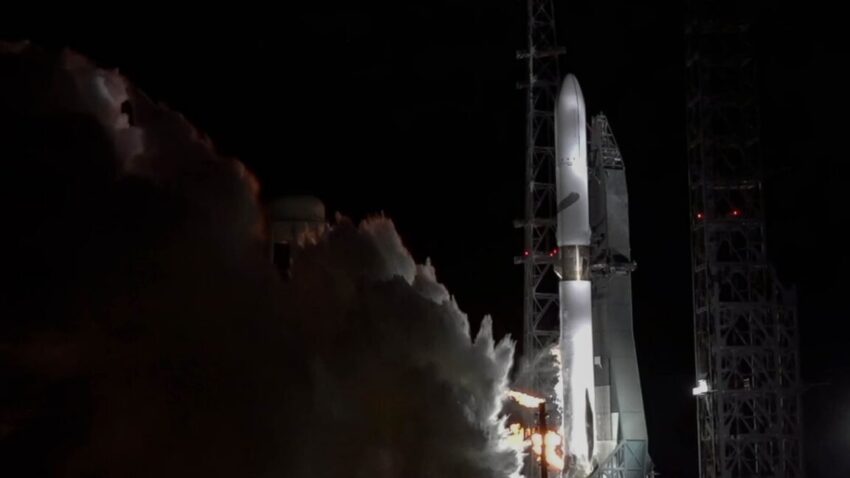
blue origin test-fires second new glenn rocket Blue Origin has made significant strides toward the upcoming launch of its New Glenn rocket with a successful test-firing of its main engines.
blue origin test-fires second new glenn rocket
Successful Test-Firing at Cape Canaveral
On Thursday night, Blue Origin conducted a pivotal test-firing of the New Glenn rocket’s seven BE-4 main engines at Cape Canaveral Space Force Station in Florida. The engines ignited at 9:59 PM EDT (01:59 UTC Friday), marking a crucial milestone in the rocket’s development. The engines burned for 38 seconds while the rocket remained securely on the ground, demonstrating the reliability and performance of the BE-4 engines.
This test-firing is particularly significant as it represents the final major test of the New Glenn rocket before its anticipated launch. Blue Origin has previously conducted successful test-firings of the rocket’s second-stage engines, but this was the first time the main engines were ignited in a hold-down configuration. Such tests are essential for validating the rocket’s systems and ensuring that everything functions as intended when it is time for liftoff.
Technical Specifications of the New Glenn Rocket
The New Glenn rocket is designed to be a heavy-lift launch vehicle capable of carrying large payloads to various orbits. Here are some key specifications:
- Height: Approximately 98 meters (322 feet)
- Payload Capacity: Up to 45 metric tons to low Earth orbit (LEO)
- Engines: Seven BE-4 engines on the first stage and two BE-3U engines on the second stage
- Reusable: Designed for reusability, allowing for multiple flights
The BE-4 engines, developed by Blue Origin, utilize liquefied natural gas (LNG) and liquid oxygen (LOX) as propellants. This choice of fuel not only provides a high thrust-to-weight ratio but also aligns with Blue Origin’s commitment to sustainable spaceflight. The ability to reuse the first stage of the rocket is expected to significantly reduce launch costs, making space access more affordable for a variety of customers, including commercial satellite operators and government agencies.
Implications of the Successful Test-Firing
The successful test-firing of the New Glenn rocket’s main engines has several implications for Blue Origin and the broader space industry. First and foremost, it demonstrates the company’s progress in developing a competitive heavy-lift launch vehicle. With the increasing demand for satellite launches and space exploration missions, having a reliable and capable rocket is crucial.
Moreover, the timing of the upcoming launch is significant. Sources indicate that the New Glenn rocket could be ready for liftoff as soon as November 9. This timeline aligns with a growing trend in the space industry where companies are racing to secure launch contracts and establish themselves as key players in the market. Blue Origin’s ability to meet this timeline could enhance its reputation and attract more customers.
Stakeholder Reactions
The successful test-firing has elicited positive reactions from various stakeholders in the aerospace sector. Industry experts and analysts view this milestone as a testament to Blue Origin’s engineering capabilities and commitment to innovation. The company has faced challenges in its development timeline, but this recent success could signal a turning point.
Investors are also closely monitoring Blue Origin’s progress. The company has received significant funding, and stakeholders are eager to see a return on their investment. A successful launch of the New Glenn rocket could bolster investor confidence and potentially lead to further financial backing for future projects.
Competition in the Heavy-Lift Market
The heavy-lift launch market is becoming increasingly competitive, with several companies vying for dominance. SpaceX, with its Falcon Heavy rocket, has established a strong foothold in this sector. Other players, such as United Launch Alliance (ULA) with its Vulcan Centaur rocket, are also in the race. Blue Origin’s New Glenn aims to carve out its own niche by offering a reliable and cost-effective solution for launching large payloads.
As the demand for satellite launches grows, the competition is likely to intensify. Companies are not only competing on price but also on reliability and launch frequency. Blue Origin’s successful test-firing positions it favorably in this competitive landscape, but the company will need to deliver on its promises to secure its place among the leading launch providers.
Future Prospects for Blue Origin
Looking ahead, Blue Origin has ambitious plans for the New Glenn rocket and its broader space exploration initiatives. The company envisions the New Glenn rocket playing a pivotal role in various missions, including satellite deployments, lunar landings, and even crewed missions to space.
In addition to the New Glenn, Blue Origin is also working on other projects, such as the New Shepard suborbital vehicle, which has successfully completed multiple crewed flights. The experience gained from these missions is expected to inform the development of the New Glenn rocket and enhance its reliability.
Conclusion
The successful test-firing of the New Glenn rocket’s main engines marks a significant milestone for Blue Origin as it prepares for its upcoming launch. With the potential for liftoff as soon as November 9, the company is poised to enter the competitive heavy-lift launch market. As Blue Origin continues to innovate and refine its technology, the implications for the aerospace industry and the future of space exploration are profound.
As the countdown to launch begins, all eyes will be on Blue Origin to see if it can deliver on its promises and establish itself as a key player in the rapidly evolving space sector.
Source: Original report
Was this helpful?
Last Modified: November 1, 2025 at 1:35 am
0 views














